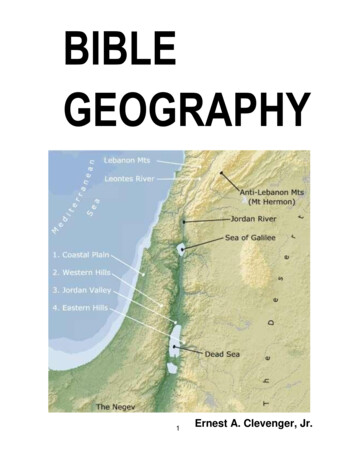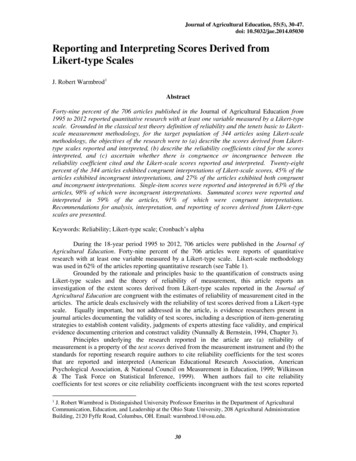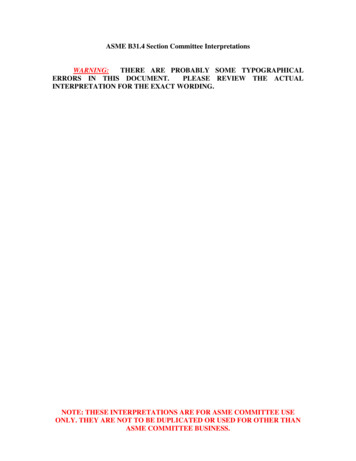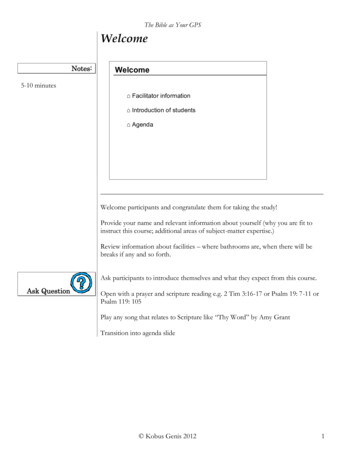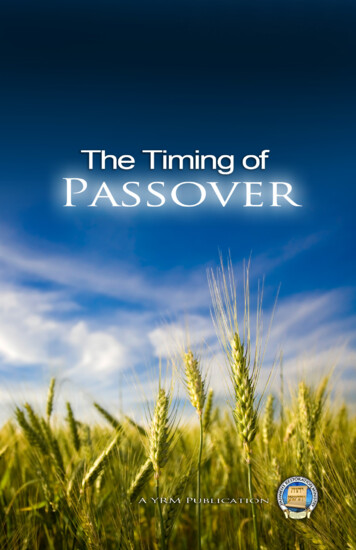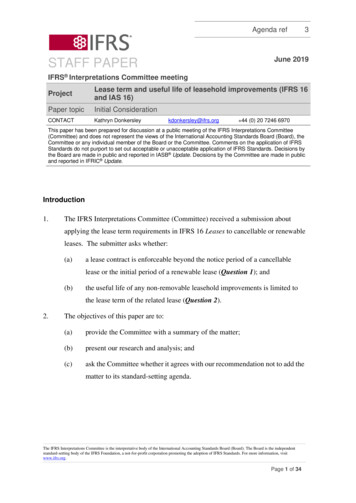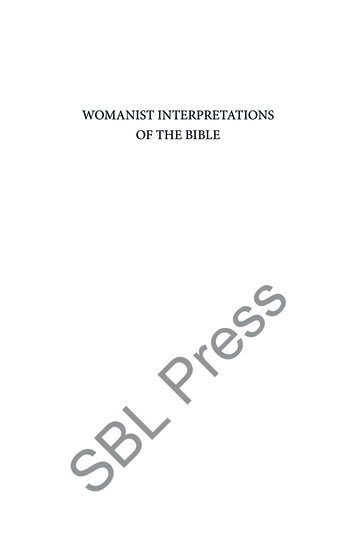
Transcription
SBLPressWomanist Interpretationsof the Bible
Semeia StudiesSteed V. Davidson, General EditorEditorial Board:Pablo R. AndiñachFiona BlackDenise K. BuellGay L. ByronMasiiwa Ragies GundaMonica Jyotsna MelanchthonYak-Hwee TanSBLPressNumber 85
Womanist Interpretationsof the BibleExpanding the DiscourseEdited bySBLPressGay L. Byron and Vanessa Lovelace
AtlantaCopyright 2016 by SBL PressAll rights reserved. No part of this work may be reproduced or transmitted in any formor by any means, electronic or mechanical, including photocopying and recording, or bymeans of any information storage or retrieval system, except as may be expressly permitted by the 1976 Copyright Act or in writing from the publisher. Requests for permissionshould be addressed in writing to the Rights and Permissions Office, SBL Press, 825 Houston Mill Road, Atlanta, GA 30329 USA.Library of Congress Cataloging-in-Publication DataSBLPressNames: Byron, Gay L., editor. Lovelace, Vanessa, editor.Title: Womanist interpretations of the Bible : expanding the discourse / edited by Gay L.Byron and Vanessa Lovelace.Description: Atlanta : SBL Press, [2016] Series: Semeia studies ; number 85 Includesbibliographical references and index.Identifiers: LCCN 2016040615 (print) LCCN 2016040794 (ebook) ISBN 9781628371529(pbk. : alk. paper) ISBN 9780884141853 (hardcover) ISBN 9780884141846 (ebook)Subjects: LCSH: Bible—Feminist criticism.Classification: LCC BS521.4 .W66 2016 (print) LCC BS521.4 (ebook) DDC 220.6082—dc23LC record available at https://lccn.loc.gov/2016040615Printed on acid-free paper.
tion: Methods and the Making of Womanist BiblicalHermeneuticsGay L. Byron and Vanessa Lovelace.1Part 1: Gender and SexualitysThe Invisible Women: Numbers 30 and the Politics of Singlenessin Africana CommunitiesStacy Davis.21esA Womanist Midrash of Delilah: Don’t Hate the Playa Hate the GameWil Gafney.49PrThe Song of Songs: Redeeming Gender Constructions in the Ageof AIDSCheryl B. Anderson.73Part 2: Agency and AdvocacySBLRace, Gender, and the Politics of “Sass”: Reading Mark 7:24–30through a Womanist Lens of Intersectionality andInter(con)textualityMitzi J. Smith.95Antitypes, Stereotypes, and Antetypes: Jezebel, the Sun Woman,and Contemporary Black WomenLove L. Sechrest.113
vicontentsOne More Time with Assata on My Mind: A Womanist Rereadingof the Escape to Egypt (Matt 2:13–23) in Dialogue with anAfrican American Woman Fugitive NarrativeShively T. J. Smith.139“Battered Love”: Exposing Abuse in the Book of JobMarlene Underwood.165Part 3: Foregrounding Women on the MarginsBlack Collectors and Keepers of Tradition: Resources for a WomanistBiblical Ethic of (Re)InterpretationGay L. Byron.187Flowing from Breast to Breast: An Examination of Dis/placedMotherhood in African American and Indian Wet NursesSharon Jacob and Jennifer T. Kaalund.209s“We Don’t Give Birth to Thugs”: Family Values, RespectabilityPolitics, and Jephthah’s MotherVanessa Lovelace.239esPart 4: Illuminating Biblical Children/ChildhoodPrOutrageous, Audacious, Courageous, Willful: Reading theEnslaved Girl of Acts 12Margaret Aymer.265“Nobody’s Free until Everybody’s Free”: Exploring Gender andClass Injustice in a Story about Children (Luke 18:15–17)Bridgett A. Green.291SBL“I Will Make Boys Their Princes”: A Womanist Reading ofChildren in the Book of IsaiahValerie Bridgeman.311
viicontentsPart 5: In ResponseMiracles and Gifts: A Womanist Reading of John 14:12–14 andEphesians 4:11–16Layli Maparyan.331Looking Forward from the Horizon: A Response in AfricanaSisterhood and SolidarityAlthea Spencer-Miller.339Challenged and ChangedKatharine Doob Sakenfeld.349The Road We Are TravelingEmilie M. Townes.359SBLPressContributors.369Ancient Sources Index.375Subject Index.384
LSBsesPr
AcknowledgmentsSBLPressWe are honored that so many of our colleagues responded enthusiastically to our invitation to contribute to this volume. For their commitmentand willingness to press the boundaries of womanist hermeneutics, we aregrateful. We are also honored that this volume includes responses by someof the leading scholars who have embraced womanist theory and praxisand who value the spirit of collaboration this volume represents.We stand on the shoulders of womanist theologians, ethicists, religious scholars, cultural critics, and biblical interpreters who dared to readtheir way through the struggle and to offer rich trajectories and paths forour own explorations. Indeed, “if it wasn’t for the(se) women,” to borrowa phrase from Cheryl Townsend Gilkes, this volume would have neveremerged from its dark womb of knowing. In particular we are grateful forRenita J. Weems and Clarice J. Martin, who have inspired our efforts andmuch of the scholarship reflected in this volume and continue to remindus that we are “just a sister away.” We are also grateful for the early support of Cheryl Kirk-Duggan and Bridgett Green, who embraced the ideaof a womanist volume when we first conceived of it. Cheryl suggested anoutline and Bridgett offered to contact potential editors, including GayByron who was serving on the Semeia Studies editorial board. Althoughthe initial outline did not come to fruition, we are appreciative of Cheryl’ssupport and encouragement in pursuing this project.We thank the Semeia Studies Editorial Board for their acceptance ofthese essays for publication and the very constructive feedback offeredduring the early phase of conceptualizing the volume. In particular, general editor Gerald West, offered great encouragement and sound advice.Steed Davidson, who succeeded Gerald as general editor, offered timelyand keen editorial support as the volume progressed toward publication.We also express our gratitude to the entire staff of SBL Press, especiallyBob Buller and Nicole Tilford, for their expert assistance throughoutthe publication process. In addition, we acknowledge Barbara Fears,-ix-
xacknowledgmentsSBLPressJonathan McPhee, and Rickdrieka Sanders for their assistance with thisvolume.We are grateful for our families and other networks of support—especially Wilfred Bentley, patient spouse to Vanessa, who endured our manyconference calls. Finally, we dedicate this volume to our children: Christopher, Shauna, Khalil, Lloyd, and PJ—who constantly remind us why sucha volume on expanding the discourse about womanist biblical interpretation is not an optional academic exercise but a necessary life-affirmingreflection of our commitment to wholeness of our entire community andpeace throughout the world.Gay L. Byron, Washington, DCVanessa Lovelace, Atlanta, GA
AbbreviationsPrimary SourcesSBLPressAg. Ap.Josephus, Against ApionAnt.Josephus, Jewish Antiquitiesb.Bablyonian TalmudB. Bat.Baba BatraBer.BerakhotB.J.Josephus, Bellum judaicumCels. Origen, Contra CelsumEmbassy Philo, On the Embassy to GaiusEp. Tra. Pliny the Younger, Epistulae ad Trajanum‘Erub. EruvinFlaccusPhilo, Against FlaccusGen. Rab.Genesis RabbahGeogr. Strabo, GeographyGos. MaryGospel of MaryGub. DeiSalvian, The Governance of GodHist. Rufinus, Eusebii Historia ecclesiastica a Rufino translata etcontinuataHist. Rufinus, Eusebii Historia ecclesiastica a Rufino translata etcontinuata; Tacitus, HistoriaeHist. rom. Dio Cassius, Historiae romanaeLet. Aris. Letter of AristeasLeuc. Clit.Achilles Tatius, Leucippe et ClitophonLing.Varro, De lingua latinaNaz. NazirNum. Rab. Numbers RabbahPhysiogn.Pseudo-Aristotle, PhysiognomonicaPoet. Aristotle, PoeticsPol. Aristotle, Politics-xi-
xiiabbreviationsŠabb. ShabbatSanh. SanhedrinSat.Juvenal, SatiresSecondary ResourcesSBLPressAARCCS American Academy of Religion Cultural Criticism SeriesAB Anchor BibleAIL Ancient Israel and Its LiteratureAJSRAssociation for Jewish Studies ReviewASOR American Schools of Oriental ResearchASV American Standard VersionATLA American Theological Library AssociationBAGDBauer, Walter, William F. Arndt, F. Wilbur Gingrich, andFrederick W. Danker. Greek-English Lexicon of the NewTestament and Other Early Christian Literature. 2nd ed.Chicago: University of Chicago Press, 1979.BASORBulletin of the American Schools of Oriental ResearchBDAG Danker, Frederick W., Walter Bauer, William F. Arndt,and F. Wilbur Gingrich. Greek-English Lexicon of the NewTestament and Other Early Christian Literature. 3rd ed.Chicago: University of Chicago Press, 2000.BDBBrown, Francis, S. R. Driver, and Charles A. Briggs. AHebrew and English Lexicon of the Old Testament. Peabody, MA: Hendrickson, 1996.BECNTBaker Exegetical Commentary on the New TestamentBibIntBiblical InterpretationBJSBrown Judaic StudiesBibliotheca SacraBSacCBQCatholic Biblical QuarterlyCDCCenters for Disease ControlCommon English TranslationCETThe Classical JournalCJCurTMCurrents in Theology and MissionDBIDictionary of Biblical Interpretation. Edited by John Hays.2 vols. Nashville: Abingdon, 1999.EDBEerdmans Dictionary of the Bible. Edited by David NoelFreedman. Grand Rapids: Eerdmans, 2000.Expository TimesExpTim
xiiiabbreviationsSBLPressFCB Feminist Companion to the BibleFCNTECW Feminist Companion to the New Testament and EarlyChristian WritingsGRGreece and RomeGSSGeneral Social SurveyHALOTKoehler, Ludwig, and Walter Baumgartner. The Hebrewand Aramaic Lexicon of the Old Testament. Translatedand edited by Mervyn E. J. Richardson. Study ed. 2 vols.Leiden: Brill, 2001.HARHebrew Annual ReviewHBM Hebrew Bible MonographsHistoriaHistoria: Zeitschrift für alte GeschichteHMML Hill Museum and Manuscript LibraryHTRHarvard Theological ReviewHUSD Howard University School of DivinityIBC Interpretation: A Bible Commentary for Teaching andPreachingIEJIsrael Exploration JournalJAHJournal of American HistoryJAOSJournal of the American Oriental SocietyJBLJournal of Biblical LiteratureJBQJewish Bible QuarterlyJFAJournal of Field ArchaeologyJFSRJournal of Feminist Studies in ReligionJournal of the Interdenominational Theological CenterJITCJNEThe Journal of Negro EducationJNHJournal of Negro HistoryJPSTanakh: A New Translation of the Holy Scriptures according to the Traditional Hebrew Text. Philadelphia: JewishPublication Society, 1985.JRAJournal of Religion in AfricaJournal of Roman StudiesJRSJournal of Religious ThoughtJRTJSBJewish Study Bible. Edited by Adele Berlin, Marc Zvi Brettler, and Michael Fishbane. Oxford: Oxford UniversityPress, 2004.JSOTJournal for the Study of the Old TestamentJSOTSupJournal for the Study of the Old Testament SupplementSeries
xivabbreviationsSBLPressJSNTJournal for the Study of the New TestamentJWJ MSSJames Weldon Johnson ManuscriptsKJVKing James VersionLCL Loeb Classical LibraryLXX SeptuagintMT Masoretic TextNA28Novum Testamentum Graece, Nestle-Aland, 28th ed.NeotNeotestamenticaNET New English TranslationNIBThe New Interpreter’s Bible. Edited by Leander E. Keck. 12vols. Nashville: Abingdon, 1994–2004.NICNT New International Commentary on the New TestamentNIGTC New International Greek Testament CommentaryNIV New International VersionNRSV New Revised Standard VersionNTL New Testament LibraryNTSNew Testament StudiesNWPC National Women’s Political CaucusOTL Old Testament LibraryPACS Philo of Alexandria Commentary SeriesPEPFAR President’s Emergency Plan for AIDS ReliefPL Patrologia LatinaPTMS Princeton Theological Monograph SeriesPneumaPneuma: Journal for the Society of Pentecostal StudiesSemeiaSt Semeia StudiesSHBC Smyth & Helwys Bible CommentarySNCC Student Nonviolent Coordinating CommitteeSNTSMS Society for New Testament Studies Monograph SeriesSP Sacra PaginaSpectrum: A Journal on Black MenSpectrumSymS Symposium SeriesTeaching Theology & ReligionTTRUNESCO United Nations Educational, Scientific, and CulturalOrganizationVetus TestamentumVTWord Biblical CommentaryWBC
Introduction:Methods and the Making ofWomanist Biblical HermeneuticsGay L. Byron and Vanessa LovelaceSBLPressWomanist Interpretations of the Bible: Expanding the Discourse is a longawaited collection of original essays that features bold new womanistapproaches to biblical hermeneutics. We first conceived of this volumethrough a series of conversations, which first began at the 2011 AnnualMeeting of the Society of Biblical Literature in San Francisco. At that time,Vanessa Lovelace shared with a group of colleagues her desire to publisha volume of womanist interpretations of the Bible to honor the trailblazing scholarship of Renita J. Weems and Clarice Martin. Around the sametime, Gay L. Byron was serving on the Semeia Studies editorial board andhaving conversations with board members and other colleagues aboutediting a volume showcasing womanist readings of the Bible. Our mutualfriend and editor, Bridgett Green, was privy to both of these conversationsand connected us together. Once we realized that we shared the same ideaand a commitment to womanist biblical scholarship, it seemed natural forthe two of us to collaborate and serve as coeditors of this volume.We both have generated various essays and articles using gender criticism, critical race theory, and other theories and methods dealing withthe interlocking oppressions of black women. Though in some cases notexplicitly identifying a womanist hermeneutic, we have been greatly influenced by the writings of author, poet, and activist Alice Walker. She isoften credited with coining the term womanist, which she first used inher essay “Coming Apart” published in the 1979 anthology Take Back theNight. In this essay, Walker wrote that a “ ‘womanist’ is a feminist, onlymore common.” She elaborated in a footnote:-1-
2byron and lovelace“Womanist” encompasses “feminist” as it is defined in Webster’s, but alsomeans instinctively pro-woman. It is not in the dictionary at all. Nonetheless, it has a strong root in black women’s culture. It comes (to me)from the word “womanish,” a word our mothers used to describe, andattempt to inhibit, strong, outrageous or outspoken behavior when wewere children: “You’re acting womanish!” A labeling that failed, for themost part to keep us from acting “womanish” whenever we could, that isto say, like our mothers themselves, and like other women we admired.(Walker 1979, 100)1Walker refined her description of womanist in her classic four-part poeticdefinition of the term in the preface to her 1983 book In Search of OurMothers’ Gardens:SBLPress1. From womanish. (Opp. of “girlish,” i.e., frivolous, irresponsible, notserious.) A black feminist of color. From the black folk expression ofmothers to female children, “You acting womanish,” i.e., like a woman.Usually referring to outrageous, audacious, courageous or willful behavior. Wanting to know more and in greater depth than is considered“good” for one. Interested in grown-up doings. Acting grown up. Beinggrown up. Interchangeable with another black folk expression: ‘Youtrying to be grown.’ Responsible. In charge. Serious. 2. Also: A womanwho loves other women, sexually and/or nonsexually. Appreciates andprefers women’s culture, women’s emotional flexibility (values tears asnatural counterbalance of laughter), and women’s strength. Sometimesloves individual men, sexually and/or nonsexually. Committed to survival and wholeness of entire people, male and female. Not a separatist,except periodically, for health. Traditionally a universalist, as in: “Mama,why are we brown, pink, and yellow, and our cousins are white, beige,and black?” Ans. “Well, you know the colored race is just like a flowergarden, with every color flower represented.” Traditionally capable, as in:“Mama, I’m walking to Canada and I’m taking you and a bunch of otherslaves with me.” Reply: “It wouldn’t be the first time.” 3. Loves music.Loves dance. Loves the moon. Loves the Spirit. Loves love and food androundness. Loves struggle. Loves the Folk. Loves herself. Regardless. 4.Womanist is to feminist as purple is to lavender. (Walker 1983, xi)1. Two lesser-known progenitors of the notion and terminology of womanism,independent of Walker, are Chikwenye Okonjo Ogunyemi (1985) and Clenora Hudson-Weems (1998). See Layli Phillips 2006.
3IntroductionPressShortly after the publication of In Search of Our Mothers’ Gardens, theterm womanist began to appear in the discipline of religious studies. Agroup of black female theological students at Union Theological Seminaryin the City of New York studying with Dr. James Cone were the first tobegin to express new black liberationist theology that was also inclusive oftheir particular experiences of sexism and racism in the academy and thechurch, perpetuated even by their own black male colleagues. The groupconsisted of doctoral students Jacquelyn Grant and Katie Geneva Cannonand Master of Divinity students Delores Williams and Kelly Brown Douglas. They began to raise critical questions regarding the absence of blackwomen’s voices in black and feminist theological discourses. It was theirexploration of black women’s tridimensional oppression of gender, race,and class that led them to embrace the term womanist to identify theirreligious thought.Womanist theological discourse expanded in 1985 when a numberof black women members of the American Academy of Religion and theSociety of Biblical Literature gathered at the first session of WomanistApproaches to Religion and Society, convened by Cheryl Townsend Gilkes.This was the beginning of womanist theological, ethical, and biblical interpretation in the academy. That same year Cannon (1985) published theformative essay “Black Feminist Consciousness,” in which she used theterms black womanist and womanist to speak of black women’s biblicalinterpretive tradition to confront racism and other forms of oppression.This was followed by Williams’s (1987) seminal essay on “Womanist Theology,” which identified the sources and methods for this new area of theological inquiry.2Also among this budding group of womanist religious scholars wasMartin, who earned her doctorate in New Testament (Christian Scriptures)in 1985 and Weems, who earned her doctorate in Old Testament (HebrewBible) in 1989.3 Weems published the monograph Just a Sister Away: ASBL2. We recognize that nineteenth-century black women such as Jarena Lee,Sojourner Truth, and Maria Stewart have a documented history of engaging in biblical interpretation in their social activism. Moreover, contemporary womanist religious scholars such as Grant, Cannon, and Williams use the Bible in their ethical andtheological formulations. However, unlike Grant, Cannon, and Williams, the formerwould not be considered womanists since the term postdates them.3. It is not evident from their dissertation titles whether Martin and Weems referto a black woman’s or womanist perspective: “The Function of Acts 8:26–40 within the
4byron and lovelaceessWomanist Vision of Women’s Relationships in the Bible in 1988. Weemscombined feminist biblical criticism with African American oral traditionto construct a womanist interpretation of stories of biblical women, suchas Sarah and Hagar (Gen 16 and 21) and Mary and Martha (Luke 10), andtheir relationships with one another. Her other writings include “ReadingHer Way through the Struggle: African American Women and the Bible”(1991), which addresses the significance of the Bible for African American female readers despite its patriarchy and use in racial and genderoppression, and “Womanist Reflections on Biblical Hermeneutics” (1993),where Weems gives her critique of the shortcomings of historical criticaland feminist biblical criticism and offers womanist biblical criticism as analternative for African American women biblical scholars.4Martin’s essays included “Womanist Interpretations of the New Testament: The Quest for Holistic and Inclusive Translation and Interpretation”(1990), where she placed the interpretive interests of women of color ingeneral and black women in particular at the forefront; “The Haustafeln(Household Codes) in African American Biblical Interpretation” (1991),which advocated for African American women and men to adopt moreliberative biblical traditions in response to the traditionally hierarchicalapproaches to the enslaved-woman regulation in the Haustafeln; and “Biblical Theodicy and Black Women’s Spiritual Autobiography” (1993), whichappears in A Troubling in My Soul: Womanist Perspectives on Evil and Suffering, edited by Emilie Townes (1993).5 In addition Martin provided thefirst comprehensive working definition of womanist biblical interpretation, which consists of four tasks:Pr1) the recovery of women’s history in the Judeo-Christian tradition byexpanding on earlier works and using appropriate methods of recovery, analysis, and reconstruction of the biblical texts and their worlds; 2)reclamation of neglected histories and stories of the presence and func-SBLNarrative Structure of the Book of Acts: The Significance of the Eunuch’s Provenancefor Acts 1:8c” and “Sexual Violence as an Image for Divine Retribution in the Prophetic Writings,” respectively.4. Weems does not use an explicitly womanist approach in her monograph Battered Love (1995). For further review of this book, see Underwood’s essay in thisvolume.5. Townes was also among the group of first-generation womanists to attend theinaugural consultation of the American Academy of Religion and the Society of Biblical Literature in 1985.
5Introductiontion of black peoples within divergent biblical traditions; 3) critique thepersistent and still normative narrowness of vision of feminist theologians and biblical interpreters on the subject of race; 4) retrieval anddocumentary analysis of the effective history of the Bible in Westernculture in general and on peoples of African descent in Black diasporiccommunities in particular. (1999, 655)SBLPressOther black women slowly began to pursue doctoral degrees in biblicalstudies. However, by the end of the 1990s, there were still only eleven whohad completed their studies and earned degrees (Bailey 2000, 696, 707).Nearly thirty years have now passed since Martin and Weems introduced readers to womanist biblical hermeneutics—biblical interpretationthat incorporated African American women’s lived experiences; and yetthe appearance of womanist biblical interpretation in books and articleshave been few and far between, despite the new addition of black womenearning terminal degrees in Hebrew Bible/Old Testament and New Testament/Early Christianity. This was due in part, as Nyasha Junior outlined inan essay on womanist biblical interpretation, to a number of circumstances.For one, while there are several works of womanist biblical interpretation, Junior noted that the preponderance has been by scholars outsidethe field of biblical studies, such as Williams (1993), Cannon (1995), andCheryl Kirk-Duggan (1997). Moreover, biblical criticism by self-identifiedwomanist scholars has not always reflected an explicitly womanist methodological approach (Byron 2002; Anderson 2004). Finally, and probablythe greatest factor, is that while black women continue to join the growingranks of blacks and women of color in biblical studies, black women biblical scholars are still underrepresented (Junior 2006, 40–41, 43).6 Even withthe increasing numbers, all black women scholars, as Junior herself noted,do not choose to identify as a womanist or feminist.Despite the circumstances and challenges noted above, recent African American commentaries such as True to our Native Land (Blount etal. 2007) and The Africana Bible (Page 2010) and feminist commentariessuch as The Women’s Bible Commentary (Newsom, Ringe, Lapsey 2012)and A Feminist Companion to the Bible series have included contributions by womanist and other black women scholars. There has also beena growing number of articles, essays, and books by black women using a6. Society of Biblical Literature US members of African descent are only 3.8 percent, which means that black women are even fewer (Society of Biblical Literature 2015).
6byron and lovelaceLPresswomanist hermeneutic. When Momma Speaks: The Bible and Motherhoodfrom a Womanist Perspective (2016) by Stephanie Buckhanon Crowderengages a womanist reading of biblical mothers, including Rizpah, Hagar,Bathsheba, Mary, the Canaanite woman, and Zebedee’s wife, to argue thattheir stories can be beneficial to contemporary women who are seekingmodels for self-identification and empowerment. In addition, Wil Gafney’s forthcoming Womanist Midrash: A Reintroduction to the Womenof the Torah and The Throne uses a midrashic interpretation rooted inAfrican American preaching traditions and imagination to bring to lifeboth familiar and often overlooked female characters in the Hebrew Bible.Other recent publications include Mitzi J. Smith’s I Found God in Me: AWomanist Reader (2015), Nyasha Junior’s An Introduction to WomanistBiblical Interpretation (2015), and Shanell Smith’s The Woman Babylonand the Marks of Empire: Reading Revelation with a Postcolonial Womanist Hermeneutics of Ambiveilence (2014), the first womanist monographsince Raquel St. Clair’s Call and Consequences: A Womanist Reading ofMark (2008).Mitzi Smith and Junior’s recent works deserve a little more attention in relation to our volume. Both scholars expressed that a motivatingfactor for writing their respective books was the lack of a textbook onwomanist biblical scholarship when they were seminary students. Smith’s(2015) edited volume provides the reader with a brief introduction to thedevelopment of womanist biblical interpretation and its growth from thepioneering works of Martin and Weems, to subsequent groups or “generations” of womanist biblical scholars, such as the second-generationscholars Gay Byron, Cheryl Anderson, and Valerie Bridgeman, thirdgeneration scholars Margaret Aymer, Wil Gafney, and Love L. Sechrest,and fourth- and recent-generation scholars Shanell Smith and BridgettGreen (M. Smith 2015, 5–7).7 The remainder of Mitzi Smith’s volume isdivided into two parts: reprinted essays of significance for an introduction to womanist biblical interpretation and womanist readings of biblical texts, both reprints and original essays.SB7. Historians usually speak of the feminist movement in terms of “waves” todefine the different periods in the movement: first wave (nineteenth to early twentiethcentury), second wave (1960s to 1980s), third wave (1990s to present). For more onthe differences between feminists’ use of waves and womanists’ use of generations, seeStacey Floyd-Thomas (2006) and Monica Coleman (2013).
7IntroductionJunior’s (2015) book is intended as an introductory-level resource onwomanist biblical interpretation for graduate students. It traces the trajectory of womanist biblical interpretation from its early roots in US blackwomen’s activism and biblical interpretation around issues of race andgender by both nonprofessionals and professionals, its development independent of feminist biblical interpretation, and its emphasis on womanistreading strategies by scholars outside of biblical studies. Junior’s monograph offers the reader a comparative analysis of feminist and womanist biblical interpretation. In particular, the book devotes several chaptersto analyzing the different waves of feminism, feminist forerunners, andfeminist biblical interpretation.8 The novice reader should understand thatJunior’s book is an introduction to both the use of feminist and womanistapproaches across disciplines rather than a generative example of womanist biblical interpretation.Diverse Range of Interpretations: Expanding the DiscourseLPressGiven the growing body of literature, this volume expands on the recentpublications on womanist biblical criticism in the following ways. First,it is intentional in naming themes and interpretive trajectories that characterize womanist hermeneutics. In this regard, our purpose is to buildupon the scholarship that has already been generated and extend theconversations and interpretive frameworks among biblical critics and allinterested readers concerned with contemporary injustices perpetratedagainst African American and other people of color throughout
Gos. mary Gospel of mary Gub. Dei salvian, The Governance of God Hist. rufinus, Eusebii Historia ecclesiastica a Rufino translata et continuata Hist. rufinus, Eusebii Historia ecclesiastica a Rufino translata et continuata; tacitus, Historiae Hist. rom. dio


